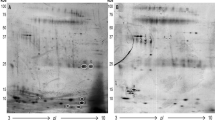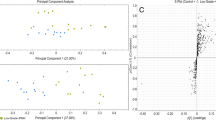Abstract
Pancreatic juice has recently been characterized in detail using proteomic methods. The cataloging of proteins from healthy individuals and those diagnosed with pancreatic cancer has revealed the presence of a number of proteins in pancreatic juice that could serve as potential biomarkers for cancer. Because obtaining pancreatic juice is not trivial, it is possible that these biomarkers can be detected in serum using more sensitive methods like ELISA. Here, we discuss the protein constituents of pancreatic juice with special reference to cancer biomarkers.
Access this chapter
Tax calculation will be finalised at checkout
Purchases are for personal use only
Preview
Unable to display preview. Download preview PDF.
Similar content being viewed by others
References
Anderson NL, Polanski M, Pieper R, et al. The human plasma proteome: a nonredundant list developed by combination of four separate sources. Mol Cell Proteomics 2004;3:311–326.
Muthusamy B, Hanumanthu G, Suresh S, et al. Plasma Proteome Database as a resource for proteomics research. Proteomics 2005;5:3531–3536.
Anderson NL, Anderson NG. The human plasma proteome: history, character, and diagnostic prospects. Mol Cell Proteomics 2002; 1:845–867.
Tirumalai RS, Chan KC, Prieto DA, Issaq HJ, Conrads TP, Veenstra TD. Characterization of the low molecular weight human serum proteome. Mol Cell Proteomics 2003;2:1096–1103.
Pieper R, Gatlin CL, Makusky AJ, et al. The human serum proteome: display of nearly 3700 chromatographically separated protein spots on two-dimensional electrophoresis gels and identification of 325 distinct proteins. Proteomics 2003; 3:1345–1364.
Satoh J, Darley-Usmar VM, Kashimura H, Fukutomi H, Anan K, Ohsuga T. Analysis of pure pancreatic juice proteins by two-dimensional gel electrophoresis in cases of pancreatic cancer. Gastroenterol Jpn 1986;21:623–629.
Goke B, Keim V, Dagorn JC, Arnold R, Adler G. Resolution of human exocrine pancreatic juice proteins by reversed-phase high performance liquid chromatography (HPLC). Pancreas 1990;5:261–266.
Gronborg M, Bunkenborg J, Kristiansen TZ, et al. Comprehensive proteomic analysis of human pancreatic juice. J Proteome Res 2004;3:1042–1055.
Rosty C, Goggins M. Early detection of pancreatic carcinoma. Hematol Oncol Clin North Am 2002; 16:37–52.
Chen R, Pan S, Brentnall TA, Aebersold R. Proteomic profiling of pancreatic cancer for biomarker discovery. Mol Cell Proteomics 2005;4:523–533.
Greenlee RT, Hill-Harmon MB, Murray T, Thun M. Cancer statistics, 2001. CA Cancer J Clin 2001;51:15–36.
Jemal A, Thomas A, Murray T, Thun M. Cancer statistics, 2002. CA Cancer J Clin 2002;52:23–47.
Yeo TP, Hruban RH, Leach SD, et al. Pancreatic cancer. Curr Probl Cancer 2002;26:176–275.
Steinberg W. The clinical utility of the CA 19-9 tumor-associated antigen. Am J Gastroenterol 1990;85:350–355.
Hanash S. Mining the cancer proteome. Proteomics 2001; 1:1189–1190.
Petricoin EF, Ardekani AM, Hitt BA, et al. Use of proteomic patterns in serum to identify ovarian cancer. Lancet 2002;359:572–577.
Srinivas PR, Srivastava S, Hanash S, Wright GL Jr. Proteomics in early detection of cancer. Clin Chem 2001;47:1901–1911.
Srivastava S, Verma M, Henson DE. Biomarkers for early detection of colon cancer. Clin Cancer Res 2001;7:1118–1126.
Verma M, Srivastava S. Epigenetics in cancer: implications for early detection and prevention. Lancet Oncol 2002;3:755–763.
Shevchenko A, Jensen ON, Podtelejnikov AV, et al. Linking genome and proteome by mass spectrometry: large-scale identification of yeast proteins from two dimensional gels. Proc Natl Acad Sci U S A 1996;93:14,440–14,445.
Gygi SP, Corthals GL, Zhang Y, Rochon Y, Aebersold R. Evaluation of two dimensional gel electrophoresis-based proteome analysis technology. Proc Natl Acad Sci U S A 2000;97:9390–9395.
Rabilloud T. Two-dimensional gel electrophoresis in proteomics: old, old fashioned, but it still climbs up the mountains. Proteomics 2002;2:3–10.
Veenstra TD. Proteome analysis of posttranslational modifications. Adv Protein Chem 2003;65:161–194.
Mann M, Jensen ON. Proteomic analysis of post-translational modifications. Nat Biotechnol 2003;21:255–261.
Shen J, Person MD, Zhu J, Abbruzzese JL, Li D. Protein expression profiles in pancreatic adenocarcinoma compared with normal pancreatic tissue and tissue affected by pancreatitis as detected by two-dimensional gel electrophoresis and mass spectrometry. Cancer Res 2004;64:9018–9026.
Lu Z, Hu L, Evers S, Chen J, Shen Y. Differential expression profiling of human pancreatic adenocarcinoma and healthy pancreatic tissue. Proteomics 2004;4: 3975–3988.
Shekouh AR, Thompson CC, Prime W, et al. Application of laser capture microdissection combined with two-dimensional electrophoresis for the discovery of differentially regulated proteins in pancreatic ductal adenocarcinoma. Proteomics 2003;3:1988–2001.
Seike M, Kondo T, Fujii K, et al. Proteomic signature of human cancer cells. Proteomics 2004;4:2776–2788.
Koopmann J, Fedarko NS, Jain A, et al. Evaluation of osteopontin as biomarker for pancreatic adenocarcinoma. Cancer Epidemiol Biomarkers Prev 2004; 13: 487–491.
Verma M, Wright GL, Jr., Hanash SM, Gopal-Srivastava R, Srivastava S. Proteomic approaches within the NCI early detection research network for the discovery and identification of cancer biomarkers. Ann N YAcad Sci 2001;945:103–115.
Mann M, Hendrickson RC, Pandey A. Analysis of proteins and proteomes by mass spectrometry. Annu Rev Biochem 2001;70:437–473.
Pandey A, Mann M. Proteomics to study genes and genomes. Nature 2000;405: 837–846.
Kristiansen TZ, Bunkenborg J, Gronborg M, et al. A proteomic analysis of human bile. Mol Cell Proteomics 2004;3:715–728.
Gygi SP, Rist B, Griffin TJ, Eng J, Aebersold R. Proteome analysis of low-abundance proteins using multidimensional chromatography and isotope-coded affinity tags. J Proteome Res 2002; 1:47–54.
Zhou H, Ranish JA, Watts JD, Aebersold R. Quantitative proteome analysis by solid phase isotope tagging and mass spectrometry. Nat Biotechnol 2002;20:512–515.
Li C, Hong Y, Tan YX, et al. Accurate qualitative and quantitative proteomic analysis of clinical hepatocellular carcinoma using laser capture microdissection coupled with isotope-coded affinity tag and two-dimensional liquid chromatography mass spectrometry. Mol Cell Proteomics 2004;3:399–409.
Meehan KL, Sadar MD. Quantitative profiling of LNCaP prostate cancer cells using isotope-coded affinity tags and mass spectrometry. Proteomics 2004;4: 1116–1134.
Everley PA, Krijgsveld J, Zetter BR, Gygi SP. Quantitative cancer proteomics: stable isotope labeling with amino acids in cell culture (SILAC) as a tool for prostate cancer research. Mol Cell Proteomics 2004;3:729–735.
Gronborg M, Kristiansen TZ, Iwahori A, et al. Biomarker discovery from pancreatic cancer secretome using a differential proteomics approach. Mol Cell Proteomics 2006;5:157–176.
Iacobuzio-Donahue CA, Ashfaq R, Maitra A, et al. Highly expressed genes in pancreatic ductal adenocarcinomas: a comprehensive characterization and comparison of the transcription profiles obtained from three major technologies. Cancer Res 2003;63:8614–8622.
Iacobuzio-Donahue CA, Maitra A, Olsen M, et al. Exploration of global gene expression patterns in pancreatic adenocarcinoma using cDNA microarrays. Am J Pathol 2003;162:1151–1162.
Iacobuzio-Donahue CA, Maitra A, Shen-Ong GL, et al. Discovery of novel tumor markers of pancreatic cancer using global gene expression technology. Am J Pathol 2002;160:1239–1249.
Mulla A, Christian HC, Solito E, Mendoza N, Morris JF, Buckingham JC. Expression, subcellular localization and phosphorylation status of annexins 1 and 5 in human pituitary adenomas and a growth hormone-secreting carcinoma. Clin Endocrinol (Oxf) 2004;60:107–119.
Wang Y, Serfass L, Roy MO, Wong J, Bonneau AM, Georges E. Annexin-I expression modulates drug resistance in tumor cells. Biochem Biophys Res Commun 2004;314:565–570.
Fang MZ, Liu C, Song Y, et al. Over-expression of gastrin-releasing peptide in human esophageal squamous cell carcinomas. Carcinogenesis 2004;25:865–876.
Pencil SD, Toth M. Elevated levels of annexin I protein in vitro and in vivo in rat and human mammary adenocarcinoma. Clin Exp Metastasis 1998;16:113–121.
Kodera Y, Isobe K, Yamauchi M, et al. Expression of carcinoembryonic antigen (CEA) and nonspecific crossreacting antigen (NCA) in gastrointestinal cancer; the correlation with degree of differentiation. Br J Cancer 1993;68:130–136.
Hasegawa T, Isobe K, Tsuchiya Y, et al. Nonspecific crossreacting antigen (NCA) is a major member of the carcinoembryonic antigen (CEA)-related gene family expressed in lung cancer. Br J Cancer 1993;67:58–65.
Sienel W, Dango S, Woelfle U, et al. Elevated expression of carcinoembryonic antigen-related cell adhesion molecule 1 promotes progression of non-small cell lung cancer. Clin Cancer Res 2003;9:2260–2266.
Scholzel S, Zimmermann W, Schwarzkopf G, Grunert F, Rogaczewski B, Thompson J. Carcinoembryonic antigen family members CEACAM6 and CEACAM7 are differentially expressed in normal tissues and oppositely deregulated in hyperplastic colorectal polyps and early adenomas. Am J Pathol 2000; 156:595–605.
Duxbury MS, Ito H, Zinner MJ, Ashley SW, Whang EE. CEACAM6 gene silencing impairs anoikis resistance and in vivo metastatic ability of pancreatic adenocarcinoma cells. Oncogene 2004;23:465–473.
Sato N, Fukushima N, Maitra A, et al. Gene expression profiling identifies genes associated with invasive intraductal papillary mucinous neoplasms of the pancreas. Am J Pathol 2004; 164:903–914.
Mori M, Shiraishi T, Tanaka S, et al. Lack of DMBT1 expression in oesophageal, gastric and colon cancers. Br J Cancer 1999;79:211–213.
Wu W, Kemp BL, Proctor ML, et al. Expression of DMBT1, a candidate tumor suppressor gene, is frequently lost in lung cancer. Cancer Res 1999;59:1846–1851.
Sasaki K, Sato K, Akiyama Y, Yanagihara K, Oka M, Yamaguchi K. Peptidomics based approach reveals the secretion of the 29-residue COOH-terminal fragment of the putative tumor suppressor protein DMBT1 from pancreatic adenocarcinoma cell lines. Cancer Res 2002;62:4894–4898.
Iacobelli S, Arno E, D’Orazio A, Coletti G. Detection of antigens recognized by a novel monoclonal antibody in tissue and serum from patients with breast cancer. Cancer Res 1986;46:3005–3010.
Iacobelli S, Arno E, Sismondi P, et al. Measurement of a breast cancer associated antigen detected by monoclonal antibody SP-2 in sera of cancer patients. Breast Cancer Res Treat 1988;11:19–30.
Iacobelli S, Bucci I, D’Egidio M, et al. Purification and characterization of a 90 kDa protein released from human tumors and tumor cell lines. FEBS Lett 1993;319:59–65.
Iacobelli S, Sismondi P, Giai M, et al. Prognostic value of a novel circulating serum 90K antigen in breast cancer. Br J Cancer 1994;69:172–176.
Christa L, Simon MT, Brezault-Bonnet C, et al. Hepatocarcinoma-intestine-pancreas/ pancreatic associated protein (HIP/PAP) is expressed and secreted by proliferating ductules as well as by hepatocarcinoma and cholangiocarcinoma cells. Am J Pathol 1999;155:1525–1533.
Christa L, Carnot F, Simon MT, et al. HIP/PAP is an adhesive protein expressed in hepatocarcinoma, normal Paneth, and pancreatic cells. Am J Physiol 1996;271:G993–G1002.
Rosty C, Christa L, Kuzdzal S, et al. Identification of hepatocarcinoma-intestine pancreas/pancreatitis-associated protein I as a biomarker for pancreatic ductal adenocarcinoma by protein biochip technology. Cancer Res 2002;62:1868–1875.
Muller HL, Oh Y, Lehrnbecher T, Blum WF, Rosenfeld RG. Insulin-like growth factor-binding protein-2 concentrations in cerebrospinal fluid and serum of children with malignant solid tumors or acute leukemia. J Clin Endocrinol Metab 1994;79:428–434.
Cohen P. Serum insulin-like growth factor-I levels and prostate cancer risk— interpreting the evidence. J Natl Cancer Inst 1998;90:876–879.
Ho PJ, Baxter RC. Insulin-like growth factor-binding protein-2 in patients with prostate carcinoma and benign prostatic hyperplasia. Clin Endocrinol (Oxf) 1997;46:333–342.
Cariani E, Lasserre C, Kemeny F, Franco D, Brechot C. Expression of insulin-like growth factor II, alpha-fetoprotein and hepatitis B virus transcripts in human primary liver cancer. Hepatology 1991;13:644–649.
Kunzli BM, Berberat PO, Zhu ZW, et al. Influences of the lysosomal associated membrane proteins (Lamp-1, Lamp-2) and Mac-2 binding protein (Mac-2-BP) on the prognosis of pancreatic carcinoma. Cancer 2002;94:228–239.
Ryu B, Jones J, Hollingsworth MA, Hruban RH, Kern SE. Invasion-specific genes in malignancy: serial analysis of gene expression comparisons of primary and passaged cancers. Cancer Res 2001;61:1833–1838.
Sanchez LM, Freije JP, Merino AM, Vizoso F, Foltmann B, Lopez-Otin C. Isolation and characterization of a pepsin C zymogen produced by human breast tissues. J Biol Chem 1992;267:24,725–24,731.
Diaz M, Rodriguez JC, Sanchez J, et al. Clinical significance of pepsinogen C tumor expression in patients with stage D2 prostate carcinoma. Int J Biol Markers 2002; 17:125–129.
Takahashi S, Suzuki S, Inaguma S, et al. Down-regulated expression of prostasin in high-grade or hormone-refractory human prostate cancers. Prostate 2003;54: 187–193.
Chen LM, Chai KX. Prostasin serine protease inhibits breast cancer invasiveness and is transcriptionally regulated by promoter DNA methylation. Int J Cancer 2002;97:323–329.
Mok SC, Chao J, Skates S, et al. Prostasin, a potential serum marker for ovarian cancer: identification through microarray technology. J Natl Cancer Inst 2001;93:1458–1464.
Author information
Authors and Affiliations
Editor information
Editors and Affiliations
Rights and permissions
Copyright information
© 2007 Humana Press Inc., Totowa, NJ
About this chapter
Cite this chapter
Grønborg, M., Maitra, A., Pandey, A. (2007). Proteomics of Human Pancreatic Juice. In: Thongboonkerd, V. (eds) Proteomics of Human Body Fluids. Humana Press. https://doi.org/10.1007/978-1-59745-432-2_17
Download citation
DOI: https://doi.org/10.1007/978-1-59745-432-2_17
Publisher Name: Humana Press
Print ISBN: 978-1-58829-657-3
Online ISBN: 978-1-59745-432-2
eBook Packages: Biomedical and Life SciencesBiomedical and Life Sciences (R0)




